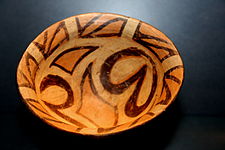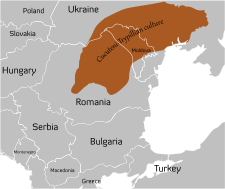- Diet of the Cucuteni–Trypillian culture
-
 Characteristic example of Cucuteni-Trypillian pottery
Characteristic example of Cucuteni-Trypillian potteryCucuteni-Trypillian culture
(5500 B.C. to 2750 B.C.) Map showing approximate extent of the Cucuteni-Trypillian culture
Map showing approximate extent of the Cucuteni-Trypillian cultureArticles about the Cucuteni-Trypillian culture: Periodization Geography Settlements · Architecture · House burning Technology · Diet · Religion · Economy · Symbols and proto-writing · Barter tokens Decline and end · Archaeogenetics Preceded by Boian culture
Followed by Yamna culturev · Cucuteni-Trypillian culture The study of the diet of the Cucuteni-Trypillian culture has provided important insights into the early history of Europe. The Cucuteni-Trypillian culture, which existed in the present-day southeastern European nations of Moldova, Romania, and Ukraine during the Neolithic Age and Copper Age, from approximately 5500 BC to 2750 B.C., left behind thousands of settlement ruins containing a wealth of archaeological artifacts attesting to their cultural and technological characteristics.[1] Refer to the main article for a general description of this culture; this article deals with its dietary practices, including techniques associated with agriculture, animal husbandry, and hunting.
Contents
Climate
For more details on this topic, see Geography of the Cucuteni-Trypillian culture.Cucuteni-Trypillian sites have yielded substantial evidence to prove that the inhabitants practiced agriculture, raised domestic livestock, and hunted wild animals for food. Although the region lying northwest of the Black Sea may not seem to have a climate or conditions favorable for the development of one of the first civilizations on earth, especially compared to other more famous cradles of civilization such as the Nile River Valley or Mesopotamia (which had warmer climates), the land and climate of the Cucuteni-Trypillian culture was actually well-suited for the development of an agricultural civilization. This region of mixed forests, rivers, mountains and plains was actually very fertile, with conditions that were well suited for human civilization.
In addition to these favorable environmental conditions of the geographical region where this culture lived, there was another factor that helped to create ideal conditions for the development of an agricultural society, namely the Holocene climatic optimum, which lasted roughly from 7000 to 3000 B.C. This era experienced warmer and moister conditions than have been present at any other time since the end of the last Ice Age to the present day, thus providing a great advantage to farmers and livestock herders.
Agriculture
See also: Neolithic RevolutionArchaeological evidence indicates that primitive plowing was done by the farmers of the Cucuteni-Trypillian settlements. Cultivating the soil, tending livestock, and harvesting the crops were probably the main occupations of most of the members of this society. There is also evidence that they may have raised bees.[2] Although wine grapes were cultivated by these people, there is no solid evidence to date to prove that they actually made wine from them. The cereal grains were ground and baked as unleavened bread in clay ovens or on heated stones in the hearth fireplace in the house.
Archaeological remains of the Cucuteni-Trypillian sites include the following cultivated grain species[3] of:
-
Club wheat,
(Triticum compactum) -
Oats,
(Avena sativa) -
Rye,
(Secale cereale) -
Proso millet,
(Panicum miliaceum) -
Peas,
(Pisum sativum) -
Perennial peavine,
(Lathyrus latifolius)
Other cultivated plant remains were found as well, including:
-
Hemp,
(Canabis sativa) -
Apricot,
(Armeniaca vulgaris) -
Cherry plum,
(Prunus cerasifera) -
Common wine grape,
(Vitis vinifera)
Artist's depiction of the Neolithic settlement at Trypillia, Ukraine
Livestock
See also: ZooarchaeologyThe archaeological remains of animals found at Cucuteni-Trypillian sites indicate that the inhabitants practiced animal husbandry. Their domesticated livestock consisted primarily of cattle, and included smaller numbers of swine, sheep and goats. There is evidence, based on some of the surviving artistic depictions of animals from Cucuteni-Trypillian sites, that the ox was employed as a draft animal.[3] Another working animal whose remains have been found in these sites is the ubiquitous dog.
Archaeologists have uncovered both the remains as well as artistic depictions of the horse in Cucuteni-Trypillian sites. However, whether these finds were of domesticated or wild horses is a matter of some debate. It is known that before domestication, humans hunted and ate wild horses, and so far there has been no absolute proof uncovered that would provide solid evidence that the horse remains found in these settlements belonged to animals that were either consumed or were used as domestic work animals. There is evidence that exists elsewhere that shows that horses were kept by some humans as domestic meat animals (similar to cattle), prior to their eventual use for draft work, and such may possibly be the case with these settlements, as well. There are still many questions as yet unanswered about this subject.[5]
The first evidence of horse domestication for use as working animals did take place during the same time that the Cucuteni-Trypillian culture flourished; depending on the source, this was from between 4000-2500 B.C. Moreover, this took place in eastern Ukraine and Kazakhstan, not far from the Cucuteni-Trypillian settlements. Archaeologists have also found horse-head clubs in Cucuteni-Trypillian sites. However, these clubs were actually imported from outside of the Cucuteni-Trypillian culture's borders, from Suvorovo, Bulgaria. Still, this does not conclusively prove one way or the other whether the Cucuteni-Trypillian culture utilized horses for transport or other work.[6]
Hunting
Members of the Cucuteni-Trypillian culture supplemented their diet with hunting. They used traps to catch their prey, as well as various weapons, including the bow-and-arrow, the spear, and clubs. To help them in stalking game, they sometimes disguised themselves with camouflage.[5]
- The archaeological remains of hunted prey included:
-
Red Deer,
(Cervus elaphus) -
Roe Deer,
(Capreolus
capreolus) -
Aurochs,
(Bos primigenius) -
Wild boar,
(Sus scrofa
ferus) -
Red fox,
(Vulpes vulpes) -
Brown bear,
(Ursus arctos)
See also
- Paleoethnobotany
- Prehistoric Romania
- History of Ukraine
- Prehistory of Southeastern Europe
- Neolithic Europe
- Chalcolithic Europe
References
- ^ Mallory, James P (1989). In search of the Indo-Europeans: language, archaeology and myth. London: Thames and Hudson. ISBN 050005052X. OCLC 246601873.
- ^ Crane, Eva (1999), The world history of beekeeping and honey hunting, New York: Routledge, pp. 40–41, ISBN 0415924677, OCLC 41049690, http://books.google.com/books?hl=en&lr=&id=ANTSvKj1AZEC&oi
- ^ a b [|Comșa, Eugen] (1973). "Cultura plantelor în cursul epocii neolitice pe teritoriul României [Cultivated plants of the Neolithic current epoch in Romanian territory]" (Romanian). Terra nostra: culegere de materiale privind istoria agriculturii în România (Our earth: selections from a material perspective of agricultural history in Romania) (Bucharest: Consiliul Superior al Agriculturii) 3: 243–252. OCLC 72954112.
- ^ "Трипольская культура ("Обзор") [Tripolskie Culture (section entitled "Survey")]" (in Russian). Словари и энциклопедии на Академике (Academic dictionaries and encyclopedias). http://dic.academic.ru. http://dic.academic.ru/dic.nsf/ruwiki/11781. Retrieved 26 January 2010. "Трипольцы выращивали пленчатую пшеницу, пленчатый и голозёрный овёс, просо, горох, ячмень, бобы, виноград, алычу, абрикосы. (The Tripoltsy raised club wheat, oats and rye, millet, peas, barley, beans (perennial peavine), grapes, damson plum, apricots.)"
- ^ a b Cucoș, Ștefan (1999). "Faza Cucuteni B în zona subcarpatică a Moldovei [Cucuteni B period in the lower Carpathian region of Moldova]" (in Romanian). Bibliotheca Memoriae antiquitatis (BMA) (Memorial Library antiquities) (Piatra Neamț, Romania: Muzeul de Istorie Piatra Neamț (Historical Museum Piatra Neamț)) 6. OCLC 223302267. http://www.neamt.ro/cmj/istorie/piatra-neamt/BMA_2.html.
- ^ [|Dergachev, Valentin A.] (2002), "Two studies in defense of the migration concept", in Boyle, Katherine V.; Renfrew, Colin; Levine, Marsha, McDonald Institute monographs, Oxford: Oxbow Books, pp. 93–112, ISBN 1902937198, OCLC 52221476, http://www.mcdonald.cam.ac.uk/publications/monographs/conference-volumes/
External links
- Archaeological Park Cucuteni The website for the multi-institutional and international project entitled "Archaeological Park Cucuteni", which seeks to reconstruct the museum at Cucuteni, Romania, and to more effectively preserve this valuable heritage site (in English and Romanian).
- Cucuteni Culture The French Government's Ministry of Culture's page on Cucuteni Culture (in English).
- Cucuteni Culture The Romanian Dacian Museum page on Cucuteni Culture (in English).
- The Trypillia-USA-Project The Trypillian Civilization Society homepage (in English).
- Трипільська культура в Україні з колекції «Платар» Ukrainian language page about the Ukrainian Platar Collection of Trypillian Culture.
- Trypillian Culture from Ukraine A page from the UK-based group "Arattagar" about Trypillian Culture, which has many great photographs of the group's trip to the Trypillian Museum in Trypillia, Ukraine (in English).
- The Institute of Archaeomythology The homepage for The Institute of Archaeomythology, an international organization of scholars dedicated to fostering an interdisciplinary approach to cultural research with particular emphasis on the beliefs, rituals, social structure and symbolism of ancient societies. Much of their focus covers topics that relate to the Cucuteni-Trypillian Culture (in English).
- The Vădastra Village Project A living history museum in Romania, supported by many international institutions.
v · Cucuteni-Trypillian culture Wikipedia articles about the Cucuteni-Trypillian culture: Periodization Periodization of the Cucuteni-Trypillian cultureGeography and Extent Geography of the Cucuteni-Trypillian cultureSettlements Settlements of the Cucuteni-Trypillian culture · Architecture of the Cucuteni-Trypillian culture · House burning of the Cucuteni-Trypillian cultureCulture Technology of the Cucuteni-Trypillian culture · Diet of the Cucuteni-Trypillian culture · Religion and ritual of the Cucuteni-Trypillian culture · Symbols and proto-writing of the Cucuteni-Trypillian culture · Economy of the Cucuteni-Trypillian culture · Barter tokens of the Cucuteni-Trypillian cultureDecline and Legacy Decline and end of the Cucuteni-Trypillian culture · Archaeogenetics of the Cucuteni-Trypillian cultureCategories:- Archaeological cultures
- Encyclopedia of Indo-European Culture
- Indo-European
- Stone Age Europe
- Archaeology of Ukraine
- Archaeology of Romania
- Archaeology of Moldova
- Prehistory of Southeastern Europe
- Neolithic Europe
- Archaeological sites in Ukraine
- Cucuteni-Trypillian culture
- Archaeological sites in Romania
Wikimedia Foundation. 2010.
Look at other dictionaries:
Decline and end of the Cucuteni–Trypillian culture — Characteristic example of Cucuteni Trypillian pottery … Wikipedia
Cucuteni-Trypillian culture — Characteristic example of Cucuteni Trypillian pottery … Wikipedia
Linear Pottery culture — LBK redirects here. For other uses, see LBK (disambiguation). Not to be confused with Linear B. Map of European Neolithic at the apogee of Danubian expansion, c. 4500–4000 BC … Wikipedia
Michelsberg culture — Geographical range Central Europe, especially West Germany. Period Later Neolithic Dates 4400–3500 BC Characteristics tulip beakers, hilltop settlements, enclosures … Wikipedia
Neolithic — An array of Neolithic artifacts, including bracelets, axe heads, chisels, and polishing tools. Neolithic stone implements are by definition polished and except for specialty items not chipped. The Neolithic … Wikipedia
Bukovina — For the Slovakian village, see Bukovina, Liptovský Mikuláš District. Bukovyna redirects here. For the Ukrainian football stadium, see Bukovyna Stadium. See also: Bukowina (disambiguation) die Bukowina Bucovina / Bukovyna … Wikipedia
Neolithic Revolution — The Neolithic This box: view · talk · edit ↑ Mesolithic … Wikipedia
Cossack Hetmanate — This article is about the Cossack state. For the government of the Ukrainian People s Republic 1918–20, see Ukrainian State. Zaporizhian Host Vassal state of the Russian Empire in 1654 1764 … Wikipedia
18+© Academic, 2000-2025- Contact us: Technical Support, Advertising
Dictionaries export, created on PHP, Joomla, Drupal, WordPress, MODx.Share the article and excerpts
-
Diet of the Cucuteni–Trypillian culture
- Diet of the Cucuteni–Trypillian culture
-
 Characteristic example of Cucuteni-Trypillian pottery
Characteristic example of Cucuteni-Trypillian potteryCucuteni-Trypillian culture
(5500 B.C. to 2750 B.C.) Map showing approximate extent of the Cucuteni-Trypillian culture
Map showing approximate extent of the Cucuteni-Trypillian cultureArticles about the Cucuteni-Trypillian culture: Periodization Geography Settlements · Architecture · House burning Technology · Diet · Religion · Economy · Symbols and proto-writing · Barter tokens Decline and end · Archaeogenetics Preceded by Boian culture
Followed by Yamna culture



















